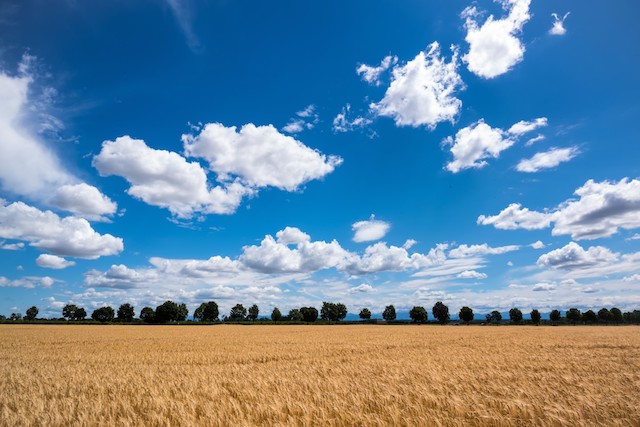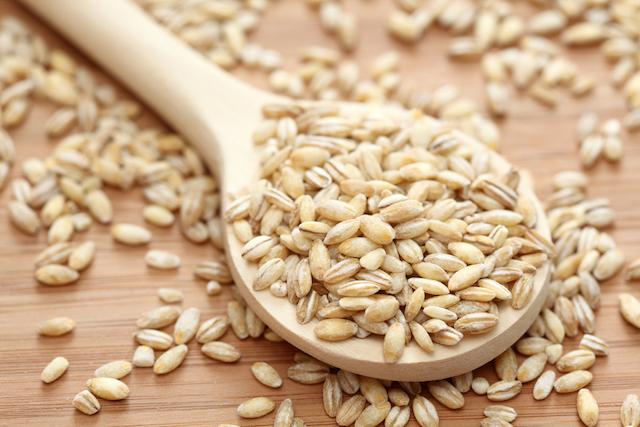Super foods, the ultimate health foods – Barley

An old-fashioned grain, barley is set to shine again as a comfort food that’s good for you. In this post I’ll tell you all about the health gains you can expect from eating more barley.
Barley – a long and fascinating history
Barley is a grain with a long history. Records of it can be found dating back to the ancient Egyptians, who used barley to make beer as well as sourdough bread. Botanically barley is close to both wheat and rye. In the Middle Ages, barley was used to make soups, hearty casseroles (similar to our modern-day risotto) and it was used to make heavy bread. Its popularity in Britain lasted until the end of the 18th century and waned only as wheat became more widely grown and cheaper.

Where you’ll find barley
Today you’ll find barley in the rice and pasta section of your supermarket. It comes in at least 6 forms:
- hulled barley (whole grains where the tough inedible outer husk or hull is taken off and used to feed animals)
- pot barley (grains with the outer husk removed and a little pearling – most of the bran layer is intact)
- pearled barley (similar to pot barley where more of the hull is removed but the kernel is pearled or polished more)
- rolled barley (like rolled oats)
- barley flour
- barley bran (to boost fibre)
 Pearl barley is the most common form of barley you'll see at supermarkets. It's the polished grain after removal or pearling of most of the outer bran, a milling process similar to milling brown rice into white rice. Yet due to its different composition, pearl barley retains quite a lot of its original fibre and nutrients so can be considered a 'whole grain' much like brown rice.
Pearl barley is the most common form of barley you'll see at supermarkets. It's the polished grain after removal or pearling of most of the outer bran, a milling process similar to milling brown rice into white rice. Yet due to its different composition, pearl barley retains quite a lot of its original fibre and nutrients so can be considered a 'whole grain' much like brown rice.
Some cooks recommend a pressure cooker to cook up barley. However, if you make sure you have enough water and allow enough time, slow cooking on the stove top will also give good results. Pearled barley will take around 45 minutes from the boil and hulled barley a little longer at 50 or 55 minutes.
What’s in barley?
As with other grains, barley is valued for its carbohydrate, fibre and B vitamin content. It’s low in fat, at only 2 per cent fat. It has virtually no sugars, sodium or cholesterol. At 8 per cent, its protein is important for vegetarians, although the quality is poorer than animal proteins such those from eggs or meat. Because it contains gluten, it is not suitable for those with coeliac disease or those with a gluten sensitivity or intolerance.
It is a source of most B vitamins, needed for energy release, together with small amounts of minerals such as potassium, phosphorus, magnesium and selenium. Unlike other grains, the fibre in barley is not just located in the outer bran layer - it’s distributed throughout the whole kernel. So even though pearled barley has been polished, it retains much of the original fibre (and B vitamins), making it a valuable source. At 7 per cent fibre, barley gives you more than white rice which has only 1 per cent fibre or even brown rice at 3 per cent.
Barley has a very low GI of 25 due to its unique mix of soluble and insoluble fibres. This helps it stabilise blood glucose levels – good news for those with diabetes, Polycystic Ovary Syndrome (PCOS) or insulin resistance. The low GI also means barley satisfies your hunger for longer, which is an effective tool for weight control.
Nutrition stats
- Two tablespoons pearl barley (weighing 30 grams or 1 oz)
| 2 g protein, 1 g fat, 25 g starch, no sugars, 2 g dietary fibre and 361 kilojoules (108 calories). |
- Per 100 grams (3 1/2oz)
| 8 per cent protein, 2 per cent fat, 84 per cent starch, trace of sugars, 7 per cent dietary fibre and 1535 kilojoules (360 calories). |
Ways to serve

- Swap barley for rice in risotto (remember to extend your cooking time)
- Include rolled barley in your muesli mix
- Bulk up a vegetable soup with a handful of barley (see my recipe here)
- Add a subtle nutty flavour to cakes or muffins by substituting a third of the wheat flour with barley flour
- Accompany your favourite casserole with boiled pearl barley as a side dish – it has a nicer nuttier flavour than brown rice or buckwheat.
- Use it as an ingredient in soups and vegetarians dishes
- Use it to make that old-fashioned lemon barley water, a refreshing drink for invalids.
Barley for malt
Barley is used for malting, a process in which barley grains are germinated and then dried and ground into malt flour, which is rich in an enzyme called alpha-amylase. Alpha-amylase breaks starch down into various sugars, which then become the substrate for yeast fermentation - a vital first step in bread baking and beer brewing.

Malt is also used in the production of vinegar and to flavour breakfast cereals and drinks. You'll spot the terms MALTED BARLEY or BARLEY MALT EXTRACT in the list of ingredients of items like Weet-Bix, Corn Flakes, Rice Bubbles, Ovaltine and Milo.
The bottom line
Barley makes for an inexpensive, filling and nutritionally impressive dish. One to keep in the cupboard. Use it in place of couscous or white rice.



